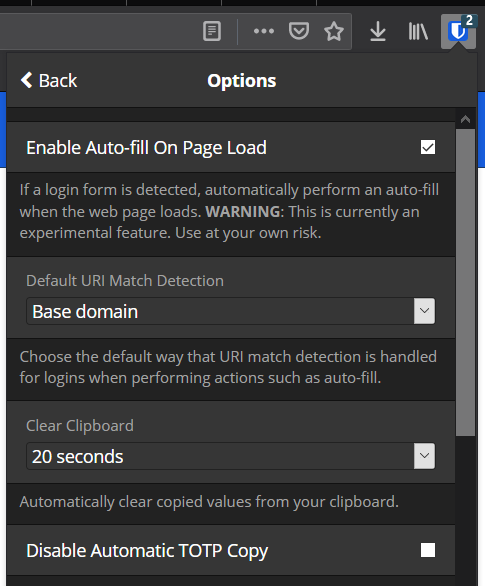

- #BITWARDEN CHROME AUTOFILL HOW TO#
- #BITWARDEN CHROME AUTOFILL MANUAL#
- #BITWARDEN CHROME AUTOFILL ANDROID#
- #BITWARDEN CHROME AUTOFILL CODE#
I went that route right away, and while I had to figure out a couple of things to make certain configuration settings persistent across container rebuilds, so far it's been nice to run it on my own hardware.Dashlane, Bitwarden, and Safari all cited by Google researchers
#BITWARDEN CHROME AUTOFILL HOW TO#
If you have the capability of running the self-hosted setup (namely a Linux box running Docker with a big chunk of RAM and a bunch of storage capacity), or just want to learn how to run such a service, then there's no harm in trying it. I've been using the right-click menu extension rather than the official shortcut, mainly because I didn't know about the shortcut. BW's autofill seems to work pretty similarly, though it does seem subtly better than LP, but that might just be subjective. I never really had any complaints with the LP autofill in Firefox on the desktop. I have yet to see any similar behavior in BW. I had times where the LP autofill kept popping up and vanishing rapidly and multiple times. It isn't as jumpy, doesn't seem to randomly flip up the autofill dialog, which then vanishes an instant later.
#BITWARDEN CHROME AUTOFILL ANDROID#
Having just started using self-hosted BitWarden myself about 3 weeks ago, the Android autofill feels better to me. However, I recommend setting tight limitations on Bitwarden's ability to auto-fill (including disabling auto-fill on page load).
#BITWARDEN CHROME AUTOFILL MANUAL#
To be clear, I'm a fan of auto-fill, and I believe that using auto-fill is safer than manual copy/paste. Next, go to the following page, which tests the autofill vulnerability to cross-site scripting (XSS) exploits:ĭo the results of the demo not cause you some concern? If you want to do an experiment, create a vault login item for the demo site, setting the URI match detection to either "Base Domain" or "Host" make a fake username and a fake password for testing purposes, and make sure that you have enabled Auto-Fill on Page Load for that item.
#BITWARDEN CHROME AUTOFILL CODE#
Perhaps you trust the domain that you logged in to, but services that are used by harmless websites for analytics, advertisements, etc., commonly inject scripts into the webpage code that may not be harmless (and have been sometimes found to contain credential-harvesting invisible login forms). Invisible input forms are a thing, and are a known method by which autofilled login credentials can be harvested and sent to a third party. For example, if you have the match detection set to "Based Domain", autofilling of your credentials will occur on every page that you visit within that domain. This works really well - much better than LastGasp ever did.ĭepending on how your URI matching is set up, Bitwarden is likely to silently autofill your login credentials on webpages that are not login forms. The Bitwarden Way is a keyboard shortcut, usually ctrl-shift-L. But it occasionally effs up, and it when it does it is bad: the user deals with a web page that inexplicably just doesn't work. The reason LP behaves so badly is they made a bad decision: they MODIFY the rendered page in order to give you those cutesy on-screen menus. So autofill works completely differently in Bitwarden. But it's nothing to jump up and down about. It's usable, especially on Android 12 or later. And they will offer better uptime and security management than you possibly could … unless you have 24×7 staff monitoring your service, responding to intrusion alerts, and curating container patches. If you choose a strong unique password, you are not dependent on the quality of Bitwarden's opsec. Am considering moving to a selfhosted bitwardenĭon't do that.


 0 kommentar(er)
0 kommentar(er)
